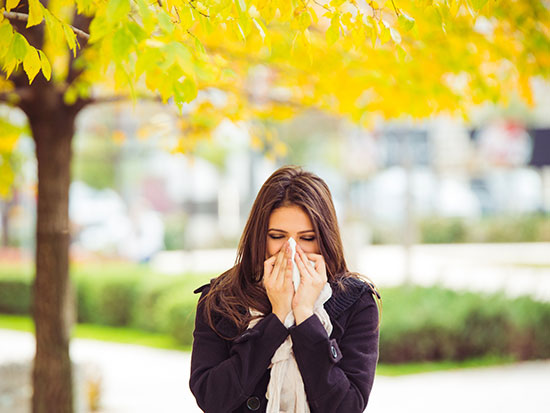 As the cooler weather moves in, the potential for fall allergies increases. One University of Alabama at Birmingham ear, nose and throat specialist says taking the right precautions and being aware of the causes can significantly reduce the risk of allergy flare-ups.
As the cooler weather moves in, the potential for fall allergies increases. One University of Alabama at Birmingham ear, nose and throat specialist says taking the right precautions and being aware of the causes can significantly reduce the risk of allergy flare-ups.
“Know your triggers and avoid those triggers,” said Do-Yeon Cho, M.D., assistant professor in the UAB Department of Otolaryngology. “First, find out if you’re allergic to any seasonal pollens. Your ENT or allergist can easily figure out allergic culprits by doing simple skin tests or blood work. If you have seasonal allergies, limit your activities outside during that specific season, wear a mask if doing yardwork, and change clothing and shower once indoors.”
Allergies or flu?
Allergies are often confused with the flu, and Cho says there are a few important distinctions to make. Runny nose, congestion and stuffy nose are all crossover symptoms that can make it hard to determine whether you have allergies or the flu. Flu symptoms tend to be more severe and can include headache, fatigue, general aches and pains, and a high fever that lasts three to four days.
Cho points out that allergies and the flu have different causes. While the flu is caused by a virus, allergies are the result of an immune system reaction. “If you have allergies and breathe in things like pollen or pet dander, the immune cells in your nose and airways may overreact to these harmless substances,” Cho said. “Your delicate respiratory tissues may then swell, and your nose may become stuffed-up or runny.”
Every season brings with it different allergens, and the most common triggers for fall allergies include pollen from weeds and mold spores that can grow in surprising places.
| “Allergy symptoms usually last as long as you’re exposed to the allergen, which may be about six weeks during pollen seasons in the spring, summer or fall.” |
“You may think of mold growing in your basement or bathroom, but mold spores also like wet spots outside with fall rain. Piles of damp leaves are ideal breeding grounds for mold,” Cho said. “There are different groups of allergy triggers that are closely tied to particular seasons. Especially in the fall, smoke from fireplaces, candy ingredients, pine trees and wreaths could be triggers.”
Cho also notes that dust mites can act as allergens in the fall. Dusting around the home obviously causes dust mites to become airborne, but in many cases dust mites can be stirred into the air the first time someone turns on their central heat in the fall.
Allergies tend to last longer than a cold or the flu, which is another distinguishing characteristic. “Colds and flu rarely last beyond two weeks,” Cho said. “Allergy symptoms usually last as long as you’re exposed to the allergen, which may be about six weeks during pollen seasons in the spring, summer or fall.”
How to avoid flare-ups
Cho says people should first identify their allergens, then consult their ENT or allergist to come up with the most effective plan to avoid allergic flare-ups. For those allergic to pollen, Cho says limiting outdoor activities when pollen counts are high is crucial. Most weather reports during allergy seasons give a pollen count.
| “Colds and flu rarely last beyond two weeks,” Cho said. “Allergy symptoms usually last as long as you’re exposed to the allergen, which may be about six weeks during pollen seasons in the spring, summer or fall.” |
Using high-efficiency particulate absorbance, or HEPA, air filters during allergy season can help reduce exposure to allergens. Cho also recommends taking allergy medication before pollen season begins, as this prevents the body from releasing histamines and other chemicals that cause allergic symptoms.
Cleanliness is very important in preventing allergic reactions.
“Bathe and shampoo daily before going to bed,” Cho said. “Wash bedding in hot, soapy water and dry your clothes in a clothes dryer, not on an outdoor line.”
He also recommends changing clothes worn during outdoor activities, as pollen and other allergens tend to cling to those fabrics.
Treatment
Fall allergies can often be treated by over-the-counter medications. Nasal steroid sprays and oral/nasal antihistamines are commonly used to treat the symptoms of fall allergies. New studies have also shown that a combination of oral antihistamines and nasal steroid sprays can provide increased efficacy.
| “Allergy shots are another potential cure for certain allergies and can be useful in controlling allergy symptoms when avoidance measures and medications provide incomplete relief.” |
“Nasal saline irrigations can also help maintain the health of your nose by improving clearance of mucous and allergens,” Cho said. “Allergy shots are another potential cure for certain allergies and can be useful in controlling allergy symptoms when avoidance measures and medications provide incomplete relief.”
Some medications should be avoided when treating allergic symptoms over sustained periods of time. “I do not recommend taking any medications with Sudafed and decongestant nasal sprays,” Cho said. “These medications may be taken over short periods, up to three days, to control acute symptoms.”
Allergies and treatments can vary from person to person, and consultation with an ENT or allergist is usually the best course of action if over-the-counter medications are not effective.